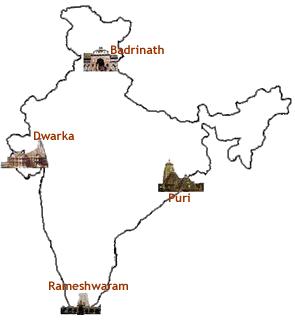
Char- Dhams is considered as the most revered travel in the lifetime of a Hindu. Every Hindu is supposed to do it once in his lifetime if he wants to erase his sins.
Adi Shankaracharya, a saint, reformer, and philosopher of ninth century AD played a prominent role in reviving Hindu dharma in Bharat. He traveled from north to south, east to west rejuvenating our culture and thus became instrumental in national integration. He was born in a Brahmin family in a town called Kaladi in Kerala (a state in southern part of Bharat). He became a sanyasi at a very young age. It is believed that he was a reincarnation of Lord Shiva. He travelled, debated with several scholars and established the authority of Hindu Dharma.
Char Dham, or Chaar Dhaams, are the sacred temples dedicated to Lord Vishnu or his incarnations (avatars). To the north is Badrinath, to the west Dwarka, to the south Rameshwaram and to the east is Puri. A brief story about all of these
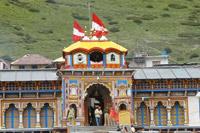 1). Badrinath : In Uttaranchal, on the banks of the Alaknanda River.
1). Badrinath : In Uttaranchal, on the banks of the Alaknanda River.Badri refers to a berry that was said to grow abundantly in the area, and Nath means Lord. The legend goes that Shankara discovered a black stone image of Lord Badrinarayan made of Saligram stone in the Alaknanda River. He originally enshrined it in a cave near the Tapt Kund hot springs. In the sixteenth century, the King of Garhwal moved the murti (idol) to the present temple.
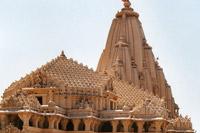 2). Dwarka : is situated on the west coast of Gujarat on the shore of the Arabian Sea.
2). Dwarka : is situated on the west coast of Gujarat on the shore of the Arabian Sea.The story behind this temple is that one day, Durvasa Muni, who was known as a saint who could be easily angered, was invited by Lord Krishna and his wife, Rukmini, to dinner. When a person is invited to dinner, etiquette dictates that the host should not eat until the guest has been satisfied. On the way to dinner, Rukmini became thirsty and asked Krishna for help. Krishna then put his foot in the ground and the Ganges water flowed forth from the earth. As Rukmini was drinking the water, however, Durvasa turned and saw her drinking without his permission. He became angry and cursed her to live apart from Lord Krishna. That is why Krishna's temple is in the town and hers is located outside the town.
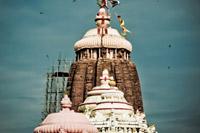 3). Puri : Puri is a small coastal town in Orissa, situated on the shoreline of the Bay of Bengal, about sixty kilometres from the capital city of Bhubaneswar.
3). Puri : Puri is a small coastal town in Orissa, situated on the shoreline of the Bay of Bengal, about sixty kilometres from the capital city of Bhubaneswar.The temple, dating back to the twelfth century, was built by an Oriya king Chodagangadeva but legend has it that it has been there since time immemorial. The temple is a huge tall structure and dominates the seaside town. Legend has it that Vishwakarma himself carved the idols out of wood. When the time came to make the idols Vishwakarma ordered for special wood and went into the temple. He stipulated that he would close the doors of the temple and would remain inside till the idols were ready and before that time no one was to enter the temple. Unfortunately, moved by the impatience of his queen, the king had the doors opened before Vishwakarma came out. When they went in they found that the God had carved all the idols up to their elbows. He was about to put on the hands but this was not to be as Vishwakarma angrily went away from there and was never seen again! So the unfinished idols had to be set in the temple and worshipped. So Jagannath, Balabhadra and Subhadra are handless here.
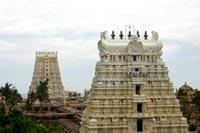 4). Rameshwaram : It is a town in Ramanathapuram district in the state of Tamil Nadu.
4). Rameshwaram : It is a town in Ramanathapuram district in the state of Tamil Nadu.According to legends the lingam was built on Rama’s return from Lanka after slaying Ravana. Ravana was a Brahmin and it was a sin to kill him even in war. Hence Rama decided to atone for this sin at the place from where he began his battle march. Hanuman was dispatched to Varanasi to bring the image of the lingam from the Kashi temple there. However he was delayed and the auspicious moment was about to pass. Therefore Sita built a lingam of sand and the prayers were conducted. This lingam is referred to as Ramalingam. When Hanuman returned with the lingam from Varanasi he was peeved to find that the prayers were completed. To placate him Sita also installed the Kashilingam and decreed that this lingam should be worshipped before the Ramalinga
